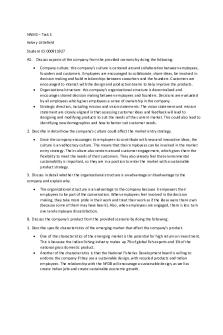DJM3-Task 1 Video Observation D094 pass on first try PDF

| Title | DJM3-Task 1 Video Observation D094 pass on first try |
|---|---|
| Course | Educational Psychology and Development of Children Adolescents |
| Institution | Western Governors University |
| Pages | 6 |
| File Size | 141.3 KB |
| File Type | |
| Total Downloads | 41 |
| Total Views | 134 |
Summary
passed on first try, be sure to provide evaluators with the competency topics listed throughout the rubric and you will be golden....
Description
Frankie Cornell D094
A. Observing and Measuring the Weather, Case #53 1. In the video #53, there were twenty students with an age range of seven to eight years old among the students of the 2nd grade classroom. 2. The developmental stage observed in the 2nd grade class is the Preoperational stage of Cognitive development. The students were introduced to new understandings of how weather is affected by earths elements and practiced measurements using standard units, which ultimately helped each student grow their overall cognitive knowledge of science and mathematics throughout the exercise. One example from the video demonstrating the Preoperational stage of cognitive development of the students is when a student was measuring water that had been effected by the recent weather, and the student was having difficulty understanding the measurement. The student did not know how to read the measurement increments on the beaker he used, which encouraged the student to learn how to read the tenths labeled on his beaker and ultimately identified the correct measurement of the water in his beaker. This example shows how this particular student established a new skill and increased his knowledge regarding measurements to use in the future. 3. A Behaviorism learning theory is utilized within the class in order to instruct the students to do the research and record the data of their experiments on their own, and analyze among their groups in order to gain a better understanding of what they are learning.
The teacher utilized a direct instructional strategy by stating clear instructions for each student and stating clear expectations of what the assignment was. The direct instructional strategy is necessary in order for the students to fully grasp the information and execute the appropriate behavior in class to learn more effectively during the assignment. The clear instructions given to the students equally ensured each student had the direction they needed in order to reach their full potential during the exercise. B. Middle School: Using Discourse to Support Students’ Understanding of Multiplying Fractions, Case #238 1. In video 238, there are eighteen students from the ages eleven to twelve in the 6th grade Math class. The class is learning new math material and are attempting to figure out new equations and rules. 2. The students are displaying the Concrete Operational stage of Cognitive development, using logic to solve equations and using examples of money and cookies. One example observed in the classroom is when the class compared a half cookie to a half of a pizza and agreed the pizza was larger than the cookie, when in reality they were both equal to one half. The students think literally and more concrete in terms and are learning to think in different ways. 3. During the lesson in video 238, the teacher uses a behaviorism learning strategy to teach about fractions in multiplication. The teacher breaks down the lesson by explain examples and scenarios the students can relate to and identify what the students must do in order to complete the exercise. The teacher assigns an assessment to the classroom in order to gain an overall understanding of the students grasp of the lesson. The opportunity for students to relate to the teacher’s examples helps students maintain a clear pathway to using logical explanations in order to understand the assignment.
C. Participating in a Structured Academic Controversy Debate about The Elgin Marbles,#1134 1. In the video 1134, there are thirty-four students ranging in age from fifteen to sixteen years old in the 10th grade World History class. 2. The developmental stage of the classroom displayed is the Formal Operational Stage of Cognitive development. The students are discussing Greek history and the relevance to modern times. Students are open to discussing many contrasting points of views and opinions, which aligns with the Social-emotional development. One example from the video displaying the development within the classroom is the listening and communication skills exhibited by the students in the discussion. The emphasis on paraphrasing past statements in order to ensure the understanding of others point of views. 3. The Constructivism learning theory was utilized during this exercise in order to allow the students to build their evidence, and reinforce their point of view on the discussion topic. An example from the video is how the teacher allows the students to steer the discussion and only steps in if the class needs redirection or clarification on a topic. This theory allows students to voice their opinions fully and show confidence in their point of view. D. Constructing Rectangular Prisms to Build Understanding of Volume, Case #2451 1. In video 2451, there are twenty-four students with ages ranging from ten to eleven years old in the 5th grade Math classroom. According to the academic progress assessments only nine of the twenty-four students are at the appropriate grade level performance. 2.The students are displaying the Concrete Operational Stage of cognitive development, because the students understand conversations and think logically. The students are able to figure out the assignment of using blocks to logically determine the volume of a rectangular prism.
3. Throughout video 2451, the teacher uses cooperative learning strategies to instruct the classroom. By placing students into smaller groups, the engagement among the groups is effective and allows the group to complete the task together. One example of the instructional strategy is when English speaking students were assigned to a group with ELL students in order to improve their language and social skills amongst the group during the exercise. The teacher states that some students are more visual learners, so they are provided with objects to illustrate an objects length and width to calculate the area and perimeter collectively with their group.
E.
The importance of understanding psychology and human development is essential to a
successful classroom as a teacher. The ability to understand the different methods in which students learn and how each student may differ from others is vital. The students deserve to be understood and given the tools that they specifically need in order to reach their full potential in class. Understanding human development will ensure the incorporation of appropriate instructional methods used in class according to the specific ages of those in the classroom. For example, if the teacher finishes teaching a lesson on over the periodic table, and notices that some seventh grade students do not seem confident in their knowledge over the material, the teacher must be able to address this issue with supplemental ways in order to help the students succeed.
F.
Understanding the differences in developmental levels of individual students will influence
my teaching practice by acknowledging the fact that all students have different attitudes and reactions to different classroom environments. Not every student will grasp the material the same way or at the same rate. Teachers must be willing to modify and make an effort to cater to the specific needs of students who may need the extra assistance in retaining the information given in class. One example of this understanding would be to evaluate how the students retain information by using various teaching methods and discover which works best overall. Although some may still have trouble, the teacher would identify what a particular student needs in order to interpret the lesson in a different way to grasp the concepts and material more effectively. This example reinforces Piaget’s theory of cognitive development stating that children move through different stages of mental development. G.
My understanding of learning theories will inform my own teaching practices by learning how
to effectively utilize most theories to provide my students with the tools and resources needed to retain and understand the knowledge taught in class. In my opinion, the Humanism theory is the basis of all other learning theories because students require the basic needs met in the classroom in order to be productive, and have the correct mindset to learn and engage. Students are not able to learn in an unstable or disruptive environment, and it is the teachers’ responsibility to provide all students with a solid foundation to build on in class every day.
Sources Constructing Rectangular Prisms to Build Understanding of volume. (2005) ATLAS. https://atlas.nbpts.org/cases/2451/ Participating in a Structures Academic Controversy Debate about The Elgin Marbles. (2015) NBPTS. https://atlas.nbpts.org/cases/1134/ Observing and Measuring the Weather. (2014) NBPTS. https://atlas.nbpts.org/cases/53/ What is Humanistic Learning Theory in Education? (2021, September 3) Western Governors University. https://www.wgu.edu/blog/what-humanistic-learning-theory-education2007.html What is the Importance of Educational Psychology for Teachers? (2011, May 20) PreserveArticles.com: Preserving Your Articles for Eternity. https://www.preservearticles.com/education/importance -of-educational-psychology-forteachers/5248...
Similar Free PDFs

DO94 Task 1 Pass on First Try
- 7 Pages

D094 Task 1 - Easy pass
- 4 Pages

First TRY
- 8 Pages

KFM2 Task 1 Video Observation
- 2 Pages

Video Observation Groupings
- 2 Pages

First Classroom Observation
- 5 Pages

Task 1 C228 WGU PASSED first TRy
- 13 Pages

The first ever video game
- 2 Pages
Popular Institutions
- Tinajero National High School - Annex
- Politeknik Caltex Riau
- Yokohama City University
- SGT University
- University of Al-Qadisiyah
- Divine Word College of Vigan
- Techniek College Rotterdam
- Universidade de Santiago
- Universiti Teknologi MARA Cawangan Johor Kampus Pasir Gudang
- Poltekkes Kemenkes Yogyakarta
- Baguio City National High School
- Colegio san marcos
- preparatoria uno
- Centro de Bachillerato Tecnológico Industrial y de Servicios No. 107
- Dalian Maritime University
- Quang Trung Secondary School
- Colegio Tecnológico en Informática
- Corporación Regional de Educación Superior
- Grupo CEDVA
- Dar Al Uloom University
- Centro de Estudios Preuniversitarios de la Universidad Nacional de Ingeniería
- 上智大学
- Aakash International School, Nuna Majara
- San Felipe Neri Catholic School
- Kang Chiao International School - New Taipei City
- Misamis Occidental National High School
- Institución Educativa Escuela Normal Juan Ladrilleros
- Kolehiyo ng Pantukan
- Batanes State College
- Instituto Continental
- Sekolah Menengah Kejuruan Kesehatan Kaltara (Tarakan)
- Colegio de La Inmaculada Concepcion - Cebu







